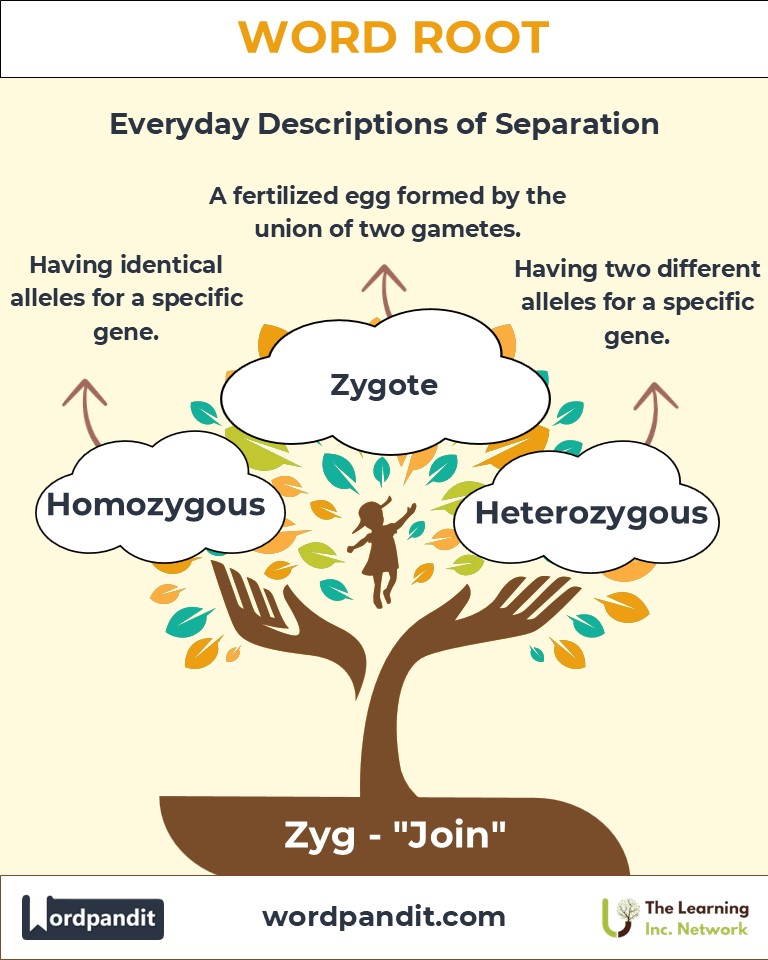Zyg: The Root of Unity in Biology and Beyond
Discover the intricate significance of the root "zyg," meaning "join" or "yoke." From the cellular beginnings of life to anatomical anomalies, this root encapsulates the essence of connection and formation in various fields.

Table of Contents
- Introduction: The Power of "Zyg"
- Etymology and Historical Journey
- Mnemonic: Unlocking the Power of "Zyg"
- Common Zyg-Related Terms
- Zyg Through Time
- Zyg in Specialized Fields
- Illustrative Story: "Zyg" in Action
- Cultural Significance of the "Zyg" Root
- The Zyg Family Tree
- FAQs about the Zyg Word Root
- Test Your Knowledge Zyg Word Root Quiz
- Conclusion: The Enduring Legacy of Zyg
1. Introduction: The Power of "Zyg"
The root "zyg," derived from the Greek word zygón (meaning "yoke" or "join"), is a cornerstone of scientific and anatomical terminology. Pronounced as "zig," it signifies connection, union, and pairing. This root is particularly notable in biology, where it forms the basis of words describing cellular fusion, development, and symmetry. Understanding "zyg" allows us to explore the fundamental principles of unity and formation in life and science.

2. Etymology and Historical Journey
"Zyg" originates from ancient Greek, where zygón referred to a yoke that joins two oxen. This imagery of joining and pairing became a metaphor for unity and symmetry. The term gained prominence in biological sciences during the 19th century, describing the fusion of gametes to form a zygote. Over time, its applications expanded to include anatomical descriptions and genetic studies, underscoring its versatility.
3. Mnemonic: Unlocking the Power of "Zyg"
To remember "zyg," picture two oxen yoked together, symbolizing connection and partnership.
Mnemonic Device: "Zyg means join, like a yoke unites two in action."
4. Common Zyg-Related Terms
- Zygote (zig-oht): A fertilized egg formed by the union of two gametes.
- Example: "The zygote is the first step in the development of a new organism."
- Azygous (ay-zig-us): Not paired; single or unpaired in anatomical structures.
- Example: "The azygous vein is an unpaired vessel in the chest cavity."
- Zygomatic (zig-oh-mat-ik): Pertaining to the cheekbone (zygomatic bone).
- Example: "The zygomatic bone is a prominent feature of the human skull."
- Homozygous (hoh-moh-zai-gus): Having identical alleles for a specific gene.
- Example: "A homozygous trait can result in uniform expression of a gene."
- Heterozygous (het-er-oh-zai-gus): Having two different alleles for a specific gene.
- Example: "Heterozygous genotypes often contribute to genetic diversity."
5. Zyg Through Time
- Zygote: The term originated in the 19th century, reflecting advancements in embryology and the understanding of fertilization.
- Azygous: Initially a term in anatomy, it highlighted unpaired structures in the human body, such as veins and muscles.
- Zygomorphic: An older term describing bilaterally symmetrical organisms, commonly used in botany.
6. Zyg in Specialized Fields
- Biology:
- Zygote: Marks the beginning of life in multicellular organisms.
- Importance: A critical stage in reproduction and genetic inheritance.
- Anatomy:
- Azygous veins: Central to the circulatory system.
- Importance: Describes unique structural anomalies.
- Genetics:
- Homozygous and Heterozygous: Explain hereditary traits.
- Importance: Fundamental to understanding genetic variation.
7. Illustrative Story: "Zyg" in Action
Dr. Maya Patel, a developmental biologist, marveled at the zygote under her microscope. It was a single cell, yet it held the potential to become a complex organism. Across the lab, an anatomy professor lectured on the azygous vein, emphasizing its unique role in human physiology. Their shared fascination with "zyg" underscored its importance across scientific disciplines, symbolizing the unity and complexity of life.
8. Cultural Significance of the "Zyg" Root
"Zyg" resonates with the universal concept of unity and connection. In ancient agrarian societies, the yoke symbolized collaboration and harmony. In modern times, "zyg" in biology represents the union of life’s building blocks, reminding us of our shared origins and interconnectedness.

9. The Zyg Family Tree
- Sym- (Greek: together):
- Symmetry: Balanced proportions.
- Con- (Latin: together):
- Conjugate: To pair or join together.
- Bio- (Greek: life):
- Biology: The study of living organisms.
10. FAQs About " Zyg "
Q: What does "zyg" mean?
A: "Zyg" originates from the Greek zygón, meaning "yoke" or "join." It signifies pairing, union, or connection, which is fundamental in biology (e.g., zygote formation) and anatomy (e.g., azygous structures).
Q: What is a zygote, and why is it important?
A: A zygote is the single cell formed by the union of a sperm cell and an egg cell during fertilization. It represents the starting point of a new organism, carrying genetic material from both parents and eventually developing into a multicellular organism through division and differentiation.
Q: What does "azygous" refer to in anatomy?
A: The term "azygous" describes structures in the body that are unpaired, unlike most anatomical features, which exist in symmetrical pairs. For example, the azygous vein is a solitary vein in the chest that drains blood from the thoracic wall and upper lumbar region.
Q: What is the significance of "zyg" in genetics?
A: In genetics, "zyg" helps describe the pairing of alleles (gene variants) at a particular locus.
Homozygous: When both alleles are identical (e.g., AA or aa).
Heterozygous: When the alleles are different (e.g., Aa).
These terms are crucial for understanding inheritance patterns and predicting traits.
Q: What is the zygomatic bone, and why is it notable?
A: The zygomatic bone, commonly known as the cheekbone, is a prominent part of the human skull. It forms the upper portion of the cheek and contributes to the orbit (eye socket). Its structure is critical for facial aesthetics and functions such as protecting the eyes.
Q: Are there cultural or symbolic meanings associated with "zyg"?
A: Yes, the idea of "joining" or "union" symbolized by "zyg" extends beyond science into cultural and philosophical realms. Ancient agrarian societies used the yoke as a symbol of teamwork and harmony, aligning with the root's original meaning.
Q: What is a zygomorphic flower in botany?
A: A zygomorphic flower exhibits bilateral symmetry, meaning it can only be divided into equal halves along one plane. Orchids and snapdragons are examples. This feature influences pollination strategies and evolutionary adaptation.
11. Test Your Knowledge: " Zyg " Mastery Quiz
1. What does the root "zyg" signify?
2. What is a zygote?
3. Which term refers to unpaired anatomy?
4. What does "homozygous" mean?
5. What bone is described by "zygomatic"?
10. Conclusion: The Living Legacy of "Zyg"
The root "zyg" highlights the beauty of unity, whether in cellular fusion, anatomical connections, or genetic pairings. Its applications span biology, genetics, and anatomy, reflecting the interconnectedness of life’s processes. By exploring "zyg," we gain a deeper appreciation for the intricate patterns that define life, urging us to marvel at the simple yet profound concept of joining.












